Are you a church sound engineer and want to build a sound booth for your church? If you are, then this blog post is going to help you with that.
In this blog post, I will give you all the necessary information about building a church sound booth.
Creating the perfect sound booth for your church is essential to enhance sound quality and minimize distractions.
In this comprehensive guide, you will get to know every aspect of designing a Church Sound Booth.
From choosing the right equipment and technology, soundproofing, wiring, and troubleshooting common issues, I will cover it all.
I’ll also explore the budget, future-proofing your sound booth, and provide you with practical tips.
This ultimate guide will ensure your church’s sound booth will be a pillar of high-quality recording, and elevate your spiritual journey.
So, without further ado, let’s dive into it.
Disclosure: This post may contain affiliate links, which means we may receive a commission if you click a link and purchase something that we recommended. Read more about Affiliate disclosure here.
Table of Contents
What is Church Sound Booth?
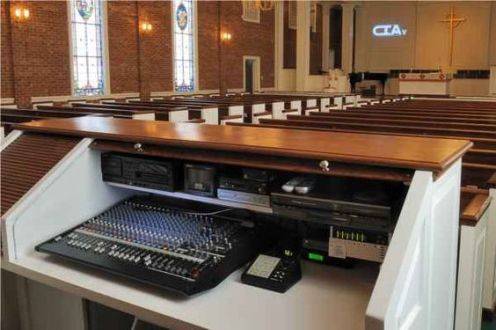
First off,
What is church sound booth and why do you need it?
Church Sound Booth is actually an enclosed space within a church where audio technicians and engineers manage and control the sound for worship songs, events, or speeches.
It is a command center for all audio equipment, which includes mixing consoles, microphones, amplifiers, and more.
Here are the advantages of church sound booth.
- High-Quality Audio: Church sound booth ensures high-quality and clear sound. It helps technicians to listen to clear sound for mixing.
- Minimize Distractions: As church is a crowded place, sound engineers can easily be distracted. Church sound booths prevent distractions from outside noise and people.
- Control: Church sound booth is treated as the control center of all the sound equipment used in the church which engineers can manage.
- Equipment Security: As valuable audio equipment is stored in the church, sound booths protect them from theft and damage.
Equipment Required to Build Church Sound Booth
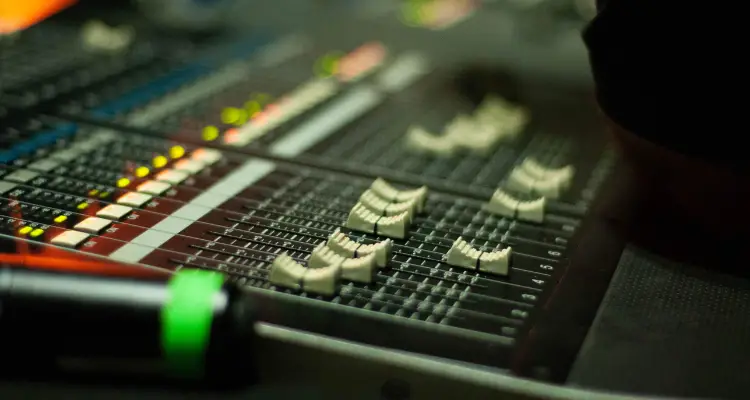
We require some sound equipment to build church sound booth that ensures optimal audio quality during worship services.
Here’s a list of essential equipment you’ll need to build church sound booth.
- Mixing Console
- Microphones
- Monitors
- Amplifiers
- Headphones
- Cables and Connectors
- Racks and Stands
- Computer and DAW
- Power Conditioner
- Acoustic Treatment
- Furniture
Space and Layout of Church Sound Booth
Planning the space and layout of a church sound booth play an important role in ensuring effective sound management during worship services.
Here are factors that you need to know for designing a good quality church sound booth:
- Right Location: Always choose a central location within the church. It should provide a clear line of sight to the stage and congregation. Clear sight will help you to manage the sound during events.
- Size: The booth size should be spacious enough to adjust the sound equipment and accommodate the technicians. Large space is a must for the proper placement of mixing consoles, monitors, and other audio gear.
- Acoustic Treatment and soundproofing: The sound booth should be properly acoustically treated so that the technicians would not distracted by outside noise.
- Visibility: The layout should be designed for a clear view of the stage. This helps sound technicians monitor events and make real-time adjustments.
- Cable Management: All the cables and wires should be properly installed from the sound booth to the stage. You can use a snake cable between the sound booth and the stage.
- Lighting: Right lighting is essential for operating equipment and interacting with the stage. Lights should not be too bright or too dim.
- Ventilation: You must ensure proper ventilation to maintain a comfortable temperature and air within the booth.
If you look carefully into these factors, you can build a well-planned sound booth that enhances the sound quality of your church.
Now let’s dive into,
How to Design the Perfect Church Sound Booth
Designing a perfect church sound booth needs your careful planning and other factors to ensure high-quality sound and functionality.
Here’s a step-by-step guide to design a perfect church sound booth.
Planning and Budgeting

First off, you should plan the structure and estimate the cost required to build that construction. This includes the blueprint of the sound booth and the list of required materials and labor cost.
When you have this list, you can build the budget by getting the price of materials and labor costs from the market.
Once you have the budget and map in your hand, you can start building the sound booth.
To build the map, you can seek professional guidance from the architect. He will plan the location, shape, and size of the sound booth for you.
Construction and Materials
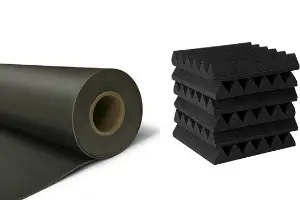
There are some common materials used to build sound booths such as,
For Soundproofing
- Acoustic foam
- Mass-loaded vinyl
- Drywall with resilient channels
For audio setup
- Microphones
- Mixers
- Amplifiers
- Speakers
- Audio interfaces
- Cables
- Mic stands etc
Along with these, you need furnitures, electrical equipment, lighting, etc.
Cable Management and Wiring
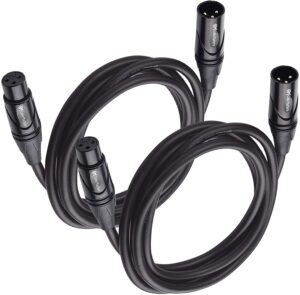
In sound booths, there are 2 types of cables used, first for audio signal transmission and second for electricity.
For electricity, you need all electric boards properly installed near the equipment. All the electrical boards and wires should comply with the power rating of the equipment.
For audio transmission from sound booth to the stage, you can use snake cable which is a bunch of XLR and TRS cables to transmit audio signals between the stage and the sound booth.
You also need mic and speaker cables to connect them with the mixer and amplifiers.
Acoustic Treatment and Isolation
Acoustic treatment is another essential thing to build a high-quality church sound booth. If the sound booth is perfectly acoustic-treated the engineers can monitor and mix in a better way.
Acoustic treatment minimizes the sound reflections from the walls and other surfaces inside the sound booth.
There are a number of materials used for perfect acoustic treatment.
Such as,
- Acoustic foam
- Bass traps
- Diffusers
- Glasswool
- Plywood
- Acoustic curtains
For more information about acoustic treatment, you can refer to my detailed guide on acoustic treatment.
Sound Testing and Calibration
Now when you have built your church sound booth, it’s time to test and calibrate the sound.
Sound testing and calibration needs a sound calibration tool which is called SPL meter. You can find it on Amazon for a few bucks.
So first off, you have to calibrate the monitor speakers. TO do this, you have to place the monitors like this image.
Note: connect all the equipment according to the manual and check the sound.
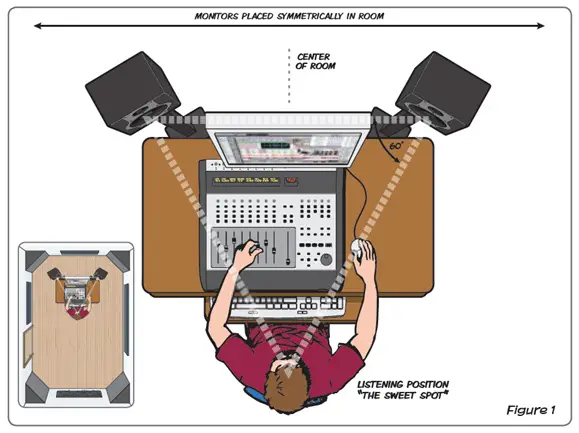
In this position, you should switch on the SPL meter and check if the SPL level is showing similar on both ears.
If yes then your monitors are perfectly calibrated. If not then you have to adjust the volumes, bass and treble to get it perfect.
Now, check the SPL level on the corners of the sound booth. It should be minimal as you have already put acoustic treatment there.
Your First Performance and Recording
Now, your sound booth is ready for performances and recordings. You should start monitoring the performances and recording the sessions.
With time your ears will get adjusted to the sound booth and you will start delivering your best mixes.
Don’t listen to a high-amplitude sound inside the sound booth. High-intensity sound can create reflections that interfere with the original sound and also damage your ears.
Regular Maintenance Practices
Regular maintenance practices are important to ensure the best performance and durability of your church sound booth. Here are facts that you need to consider about regular maintenance practices.
- Regular Cleaning the equipment and sound booth: You should regularly clean all components of the sound booth, such as microphones, speakers, mixing consoles, cables, furniture, walls and surfaces.
- Regularly Inspect for Wear and Tear: You must regularly inspect cables, connectors, and equipment for signs of wear and damage. If damaged replace them immediately.
- Update software and firmware regularly: You must keep audio software and firmware up-to-date. This will fix bugs and make the performances smooth.
- Test and Calibrate the sound: Regularly test and calibrate the sound system. This will optimize the sound quality. Optimize and correct the levels, equalization, and speaker placement.
- Consult Manufacturers if you find any defects: Refer to the manufacturer if you find any defect in the equipment.
Conclusion
So, here is a detailed guide on building a church sound booth.
Building a church sound booth is not rocket science, you can do it on your own or with the help of professionals.
You just need proper knowledge of how to build a perfect church sound booth which includes choosing the right equipment, connections, and soundproofing. Once you know the blueprint you are ready to start the construction.
And I think this guide has already given the basic k knowledge of building a perfect sound booth.
Now it’s time to build your own.
Let me know if you face any problems during the construction. I will definitely guide you on this.
Related,

![Top 9 Best Amps for Blues [2024]](https://www.recordingbase.com/wp-content/uploads/2023/12/best-amps-for-blues.png)
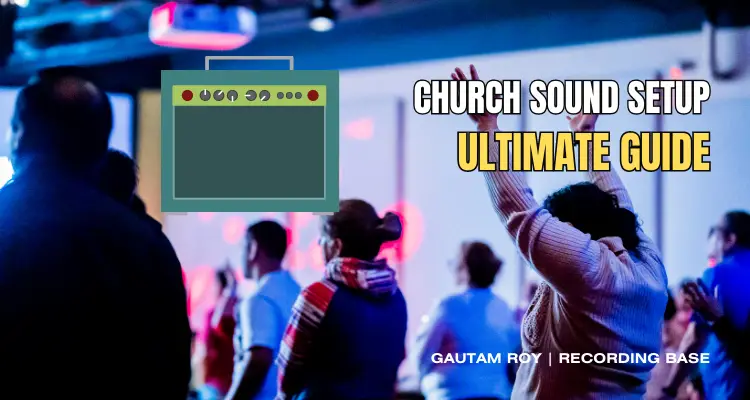

![9 Best Digital Mixers For Church [2024]](https://www.recordingbase.com/wp-content/uploads/2023/07/Best-Digital-Mixers-For-Church.png)

